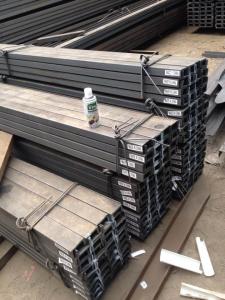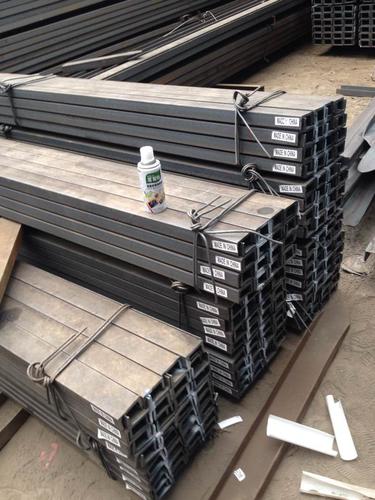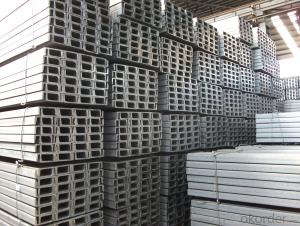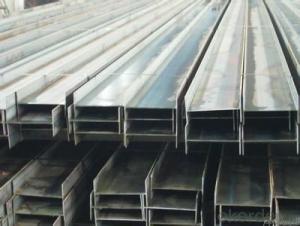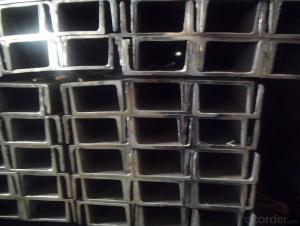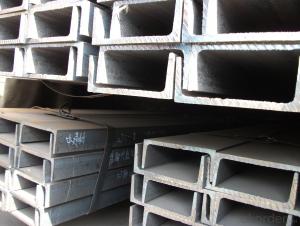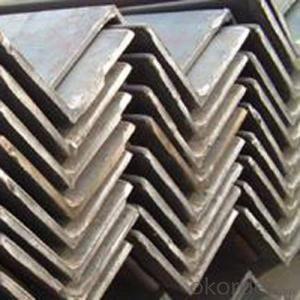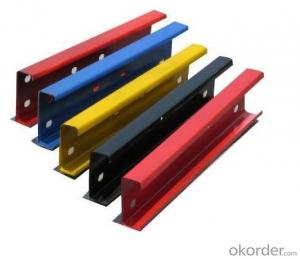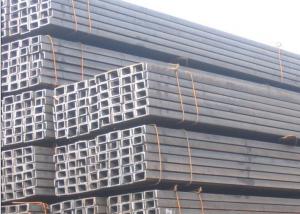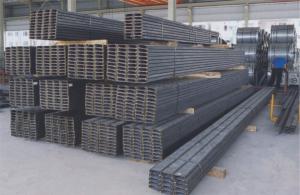Hot Rolled Steel Channel U Shape Section
- Loading Port:
- China Main Port
- Payment Terms:
- TT or LC
- Min Order Qty:
- 100 m.t.
- Supply Capability:
- 5000MT m.t./month
OKorder Service Pledge
OKorder Financial Service
You Might Also Like
Product Description:
OKorder is offering Hot Rolled Steel Channel U Shape Section at great prices with worldwide shipping. Our supplier is a world-class manufacturer of steel, with our products utilized the world over. OKorder annually supplies products to African, South American and Asian markets. We provide quotations within 24 hours of receiving an inquiry and guarantee competitive prices.
Product Applications:
Hot Rolled Steel Channel U Shape Section are ideal for structural applications and are used in main bearing structure, and they could be welded in order to support or hang a variety of facilities. They are also usually used in combination with I beam. The channel steel with sizes under 140mm is usually applied to construction engineering, as purline, while the channel steel with sizes above 160mm is more likely to be used in building vehicle chassis structure and mechanical structure. Furthermore, the channel steel in sizes above 300mm is target at building bridge structure, as tension bar.
Product Advantages:
OKorder's Hot Rolled Steel Channel U Shape Section are durable, strong, and wide variety of sizes.
Main Product Features:
· Premium quality
· Prompt delivery & seaworthy packing (30 days after receiving deposit)
· Can be recycled and reused
· Mill test certification
· Professional Service
· Competitive pricing
Product Specifications:
Manufacture: Hot rolled
Grade: Q195 – 235
Certificates: ISO, SGS, BV, CIQ
Length: 6m,12m, as per customer request
Packaging: Export packing, nude packing, bundled
| JIS STANDARD CHANNEL | ||||||
| SIZE(MM) | h(mm) | b(mm) | s(mm) | t(mm) | kg/m | length |
| 75X40x3.8x7 | 75 | 40 | 3.8 | 7 | 5.3 | 6m,12m |
| 75X40x5x7 | 75 | 40 | 5 | 7 | 6.92 | 6m,12m |
| 100X50x3.8x6 | 100 | 50 | 3.8 | 6 | 7.3 | 6m,12m |
| 100X50x5x7.5 | 100 | 50 | 5 | 7.5 | 9.36 | 6m,12m |
| 125X65x5.2x6.8 | 125 | 65 | 5.2 | 6.8 | 11.66 | 6m,12m |
| 125X65x6x8 | 125 | 65 | 6 | 8 | 13.4 | 6m,12m |
| 150x75x5.5x7.3 | 150 | 75 | 5.5 | 7.3 | 14.66 | 6m,12m |
| 150x75x6.5x10 | 150 | 75 | 6.5 | 10 | 18.6 | 6m,12m |
FAQ:
Q1: what is the difference between actual weight and theoretical weight?
A1: All the section steel has two weights: actual weight and theoretical weight. Actual weight is the weighing out when the product delivered from the mill. Theoretical weight is calculated by pieces. The invoice can be based on each of them as your request.
Q2: How many tons of steel products could be loaded in containers?
A2: Usually the steel products are delivered by bulk vessel because of the large quantity and the freight. However, there are no bulk vessel enter some seaports so that we have to deliver the cargo by containers. The 6m steel product can be loaded in 20FT container, but the quantity is changed according to the size, usually from 18tons to 25tons.
Q3: How soon can we receive the product after purchase?
A3: Within three days of placing an order, we will arrange production. The normal sizes with the normal grade can be produced within one month. The specific shipping date is dependent upon international and government factors, the delivery to international main port about 45-60days.
Images:
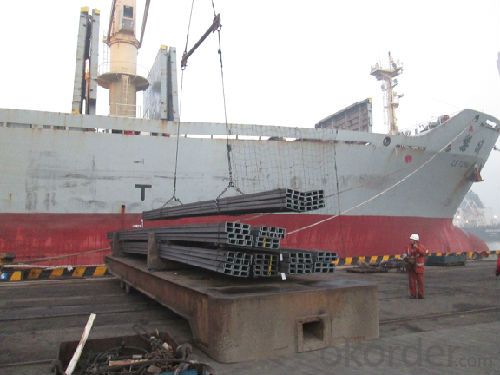
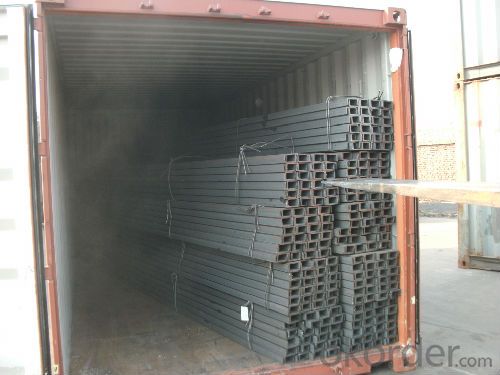
- Q: How do steel channels contribute to the overall safety of a structure?
- Steel channels contribute to the overall safety of a structure by providing structural support and stability. They are used to reinforce beams, columns, and frameworks, enhancing the load-bearing capacity of the structure. Additionally, steel channels can help distribute and redirect forces, such as those caused by wind or seismic activity, reducing the risk of structural failure. Their high strength and durability make them resistant to deformation and ensure long-term stability, further enhancing the safety of the entire structure.
- Q: Can steel channels be used for industrial applications?
- Certainly, steel channels are an excellent choice for industrial applications. These versatile structural components are commonly utilized in various industrial settings. Typically crafted from hot-rolled steel, steel channels are available in a variety of sizes and shapes, meeting the diverse requirements of different industries. In industrial projects such as buildings, bridges, and infrastructure, steel channels are frequently employed for structural support. With their exceptional strength and stability, they can withstand heavy loads and harsh environmental conditions. Moreover, steel channels are commonly integrated into the construction of platforms, walkways, and staircases, ensuring a secure and robust framework for industrial access and safety. Additionally, steel channels play a significant role in the manufacturing sector. They are widely used in the creation of machinery, equipment, and storage systems. By forming frames and supports for conveyor belts, shelving units, and racking systems, steel channels provide the necessary rigidity and durability, ensuring the stability and longevity of industrial equipment. Moreover, steel channels find applications beyond their structural uses. In industrial settings, they can be utilized for electrical and plumbing installations. Serving as raceways or conduits for electrical wiring and piping systems, steel channels offer a safe and organized solution for routing utilities and cables. In conclusion, steel channels bring forth a plethora of advantages that render them highly suitable for industrial applications. Their strength, versatility, and durability make them a reliable choice for supporting structures, machinery, and various industrial systems.
- Q: What is the load-carrying capacity of steel channels?
- The load-carrying capacity of steel channels depends on various factors such as the dimensions and material properties of the channel, the type and distribution of the load, and the support conditions. Steel channels are typically designed to withstand both bending and axial loads. The load-carrying capacity of a steel channel can be determined using engineering calculations and standards such as the American Institute of Steel Construction (AISC) Manual. These calculations consider the section properties of the channel, including its moment of inertia and section modulus, which indicate its resistance to bending and deformation under load. The load-carrying capacity can also be influenced by the material strength of the steel channel. The yield strength and ultimate tensile strength of the steel determine its ability to resist deformation and failure under load. Higher strength steel channels can typically carry larger loads. Additionally, the support conditions of the steel channel play a crucial role in its load-carrying capacity. Channels with fixed or pinned supports will have different load-carrying capacities compared to those with simply supported or cantilevered ends. To determine the specific load-carrying capacity of a steel channel, it is recommended to consult engineering references, design codes, or consult with a structural engineer or steel manufacturer.
- Q: Are steel channels suitable for modular construction?
- Yes, steel channels are suitable for modular construction. They are commonly used in modular construction due to their strength, durability, and versatility. Steel channels provide structural support and can be easily assembled and connected to create modular units. Additionally, steel channels can withstand heavy loads and provide stability, making them an ideal choice for modular construction projects.
- Q: What about the specification of channel steel?
- The same height of the channel, if there are several different leg width and waist thickness, also need to add a B C on the right side of the model to distinguish, such as 25a#, 25b#, 25c# and other meters.
- Q: Can steel channels be used in load-bearing applications?
- Absolutely, load-bearing applications can certainly make use of steel channels. In construction and engineering undertakings, steel channels find frequent employment due to their commendable robustness and durability. Their purpose is to furnish structural reinforcement and ensure uniform weight distribution. Steel channels possess the capacity to endure substantial loads and exhibit remarkable resistance against bending and torsional stresses. Moreover, they lend themselves effortlessly to customization and adaptation, rendering them well-suited for an array of load-bearing applications encompassing bridges, edifices, heavy machinery, and infrastructure projects.
- Q: Are steel channels suitable for structural applications?
- Yes, steel channels are suitable for structural applications. They are commonly used in the construction industry for their strength, durability, and versatility. Steel channels provide structural support and are often employed in beams, columns, and other load-bearing structures.
- Q: Are steel channels suitable for the mining parts manufacturing industry?
- Yes, steel channels are suitable for the mining parts manufacturing industry. Steel channels offer high strength and durability, making them ideal for withstanding the harsh conditions and heavy loads often encountered in the mining industry. Additionally, steel channels can be easily fabricated and customized to meet specific design requirements, making them a versatile choice for manufacturing various mining parts and components.
- Q: What are the different types of bracing systems used with steel channels?
- There are several types of bracing systems used with steel channels, including knee bracing, cross bracing, and diagonal bracing. Knee bracing involves using steel angles to connect the channel to the supporting structure, providing lateral stability. Cross bracing involves diagonal members connecting different channels or sections, increasing overall rigidity. Diagonal bracing consists of diagonal members connecting the top and bottom flanges of the channel, providing stability against lateral loads.
- Q: What are the different types of connections for steel channels in curtain wall systems?
- There are several different types of connections that can be used for steel channels in curtain wall systems. Some of the most common types include: 1. Bolted Connections: This type of connection involves using bolts to secure the steel channels to other structural elements or to the curtain wall system. Bolted connections are often preferred for their simplicity and ease of installation. 2. Welded Connections: Welding involves fusing the steel channels to other structural elements or to the curtain wall system using heat. Welded connections provide a strong and durable bond, but they require skilled labor and can be more time-consuming to install. 3. Clamped Connections: Clamped connections involve using clamps or brackets to hold the steel channels in place. This type of connection is often used when there is a need for adjustability or when it is desirable to avoid drilling or welding. 4. Adhesive Connections: Adhesive connections involve using high-strength adhesives or epoxy to bond the steel channels to other structural elements or to the curtain wall system. Adhesive connections provide a clean and aesthetically pleasing look, but they may not be suitable for all applications. 5. Combination Connections: In some cases, a combination of different connection types may be used to achieve the desired strength, adjustability, or aesthetic appearance. For example, a curtain wall system may use bolted connections for primary structural support and clamped connections for secondary support or adjustability. It is important to note that the choice of connection type will depend on various factors such as the specific requirements of the project, the load-bearing capacity needed, the architectural design, and the availability of materials and skilled labor. Consulting with a structural engineer or curtain wall specialist is recommended to determine the most appropriate connection type for a given application.
Send your message to us
Hot Rolled Steel Channel U Shape Section
- Loading Port:
- China Main Port
- Payment Terms:
- TT or LC
- Min Order Qty:
- 100 m.t.
- Supply Capability:
- 5000MT m.t./month
OKorder Service Pledge
OKorder Financial Service
Similar products
Hot products
Hot Searches
Related keywords
